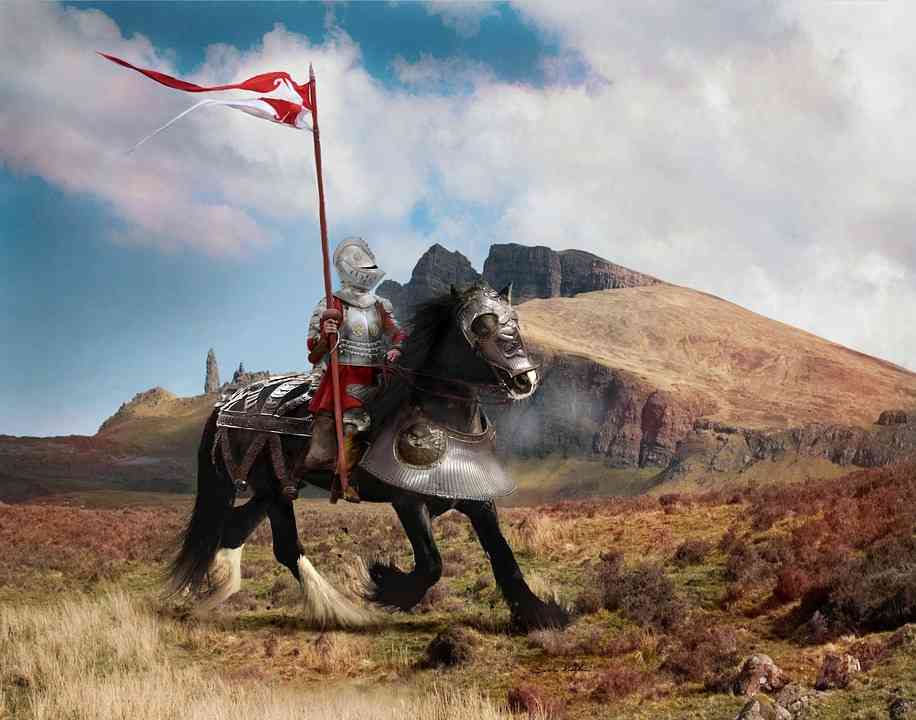Knight and Parson both the characters are very minutely painted by the poet in “Prologue to the Canterbury Tales”. They have very less shortcomings. Knight idealises Chivalry whereas Parson is ideal for the religious class. Chaucer’s characterization is worth mentioning, as he is a keen observer of humanity. He knows human nature very well and by closely observing it, depicts in detail what he sees. His characters are not motionless. They move, laugh and talk on the way to Canterbury. Chaucer is called a painter of words. He makes pen pictures of characters whom he sees during his journey. Like a dramatist, he first describes his characters and then by mentioning their attributes, leaves his readers to judge them. Let us shed light on both parallel characters one by one.
The Knight in Prologue to the Canterbury Tales:
Knight is the very first character in Prologue to the Canterbury Tales. Chaucer describes him as a brave and lovely person. He fought for his country as well as for his religion. Chaucer does not only observe his clothes but also his nature. According to him, the Knight likes simplicity. He is accompanied by a Square. He has won many battles for his people. He lacks pride unlike other knights of the era. Bravery and courtesy are the two major ingredients, which have been observed by Chaucer. The Knight, on many occasions, was awarded to be the head of the table. He stood behind his masters at the time of their feasting. The knight is a symbol of the upper class of the fourteenth century.
The Parson in Prologue to the Canterbury Tales:
On the other hand, the parson is a symbol of religion. By reading about this character, readers could easily draw the conclusion that the total religious class was not corrupt at all. There were some persons in that society, which were spending life for others. The Parson was a very humble and generous person. He gave tithes to others from his own pocket. He visited the oppressed people even in rain with a stick in his hand. He was a very pious man, who did his best to save himself from the dread of God. Chaucer describes the parson as an ideal religious person in “Prologue to the Canterbury Tales”. He helped the poor as well as the sinners. He loved sinners but hated sin. He was of the view that if gold rusted what would iron do? He first acted on the gospel of Christ and then preached it to other people.
Similarities In Parson and Knight:
For the sake of comparison, it would be advantageous to mention here that the knight, the parson and the clerk are idealised conceptions. Chaucer has given them superiority over other characters on the basis of their behaviours. Knight and parson both are humble and pious. Knight was living life for his country and religion. In fact, he fought for his country and religion. Similarly, the parson also shared the same attributes. He was also living a life, which was devoted to either God or his creation (humanity). Thus, the common characteristics of both of them are that they were not living for themselves but for others. They liked simplicity. They did not seek the attention of others. They were not corrupt and they did not feel proud in helping others in any way. Consequently, both these characters share many similarities to the extent of simplicity, helping other people and spending life for religion.
Dissimilarities Between Parson and Knight:
So far as dissimilarities in them are concerned, the knight is a representative of feudalism whereas the parson is a symbol of the religious class. In this way, the parson represents virtue in the ecclesiastical world but the knight in the secular world. According to Chaucer, the parson was a poor person but the Knight did not seem to be poor but a person from the upper class. The knight shared qualities of bravery. Meaning thereby, he served humanity with his strong body and training but the parson helped the deities with his pure heart. Knight was good in the eyes of his masters but the parson wanted to become virtuous in the eyes of God. The knight is a person who signified worldly success but the parson indicated success in eternal life.
By and large, the final analysis of the above discussion is that Chaucer very skillfully paints the knight and the parson in “Prologue to the Canterbury Tales”. Very rare characters represent the virtue of the 14th century. Most of the characters are either corrupt or bad but the knight and parson are different from them. They are neither corrupt nor bad from their heart. They share similarities such as humble life, modest behaviour, serving nature and above all representation of their specific classes.
Chaucer has balanced his book by describing a character in contrast to the other. Parson is not in contrast to the knight in “Prologue to the Canterbury Tales” but similar to it in one way or the other. In many manners, the knight and the parson are similar to each other as they both have common attributes. Hence, there are more similarities but fewer divergences between the parson and the knight in “Prologue to the Canterbury Tales”.
Related Questions:
- Compare and contrast the knight with the parson in “Prologue to the Canterbury Tales”
